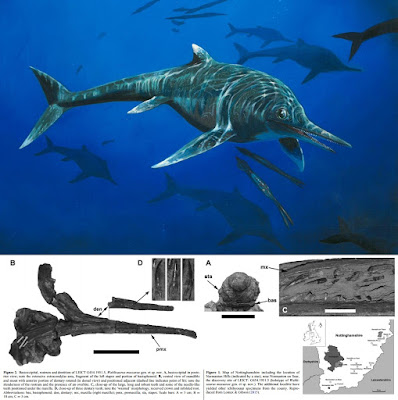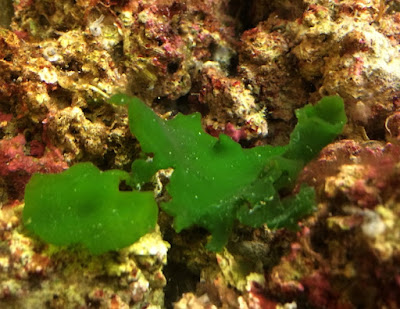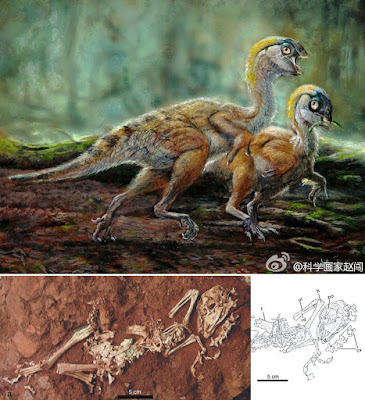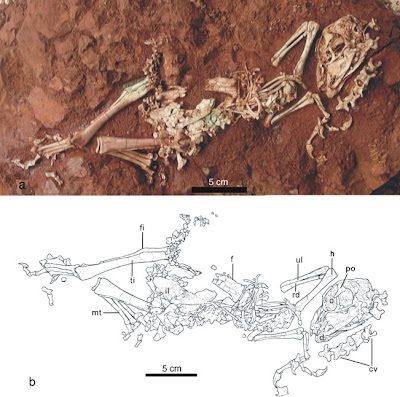[Most Recent Entries] [Calendar View]
Sunday, June 19th, 2016
| Time | Event | ||||
| 3:43a | [Paleontology • 2016] Wahlisaurus massarae • A New Leptonectid Ichthyosaur from the Lower Jurassic (Hettangian) of Nottinghamshire, England, UK, and the Taxonomic Usefulness of the Ichthyosaurian Coracoid Abstract Thousands of ichthyosaurs have been discovered from the rich Lower Jurassic deposits of the UK, with the majority collected from along the Lyme Regis-Charmouth area of the Dorset coast. Here, I describe a new leptonectid ichthyosaur, Wahlisaurus massarae gen. et sp. nov., based on a partial skull and an incomplete skeleton collected from the Lower Jurassic (Hettangian) of Nottinghamshire, England. Wahlisaurus can be referred to the Leptonectidae through the possession of an extremely slender and delicate snout, and a mandible shorter than the snout which produces an overbite. This referral is supported by a phylogenetic analysis. The new taxon is distinguished from other ichthyosaurs through a unique combination of characters and autapomorphies of the pectoral girdle including the presence of both a scapular-coracoid foramen and a large and roughly ovoid coracoid foramen. A coracoid foramen has only previously been reported in the Triassic ichthyosaur Cymbospondylus. The peculiar coracoid morphology further highlights the taxonomic utility of coracoids in ichthyosaurs. The aforementioned features demonstrate that W. massarae cannot be referred to any currently recognized leptonectid. Wahlisaurus is the ninth Lower Jurassic ichthyosaur genus to be recognized worldwide, and the fifth documented in the Lower Lias Group. Keywords: ichthyosaur, Wahlisaurus massarae, Nottinghamshire, leptonectid, Lower Jurassic, Hettangian Systematic palaeontology Order Ichthyosauria de Blainville, 1835 Minorder Parvipelvia Motani, 1999b Suborder Neoichthyosauria Sander, 2000 Family Leptonectidae Maisch, 1998 Genus Wahlisaurus gen. nov. Type species. Wahlisaurus massarae sp. nov. Derivation of name. In honour of William (Bill) Wahl for his contribution to the study of Mesozoic marine reptiles and for introducing the author to the study of the group. Wahlisaurus massarae sp. nov. Holotype. LEICT G454.1951.5, a partial skull and an associated incomplete skeleton comprising the pectoral girdle, humeri, pelvic elements, partial hind fins, vertebrae and ribs. Only known specimen. Derivation of name. In honour of Professor Judy Massare for her significant contribution to the study of Mesozoic marine reptiles, especially ichthyosaurs, and for introducing the author to the study of the group. Diagnosis. Small-bodied leptonectid ichthyosaur with the following autapomorphies: coracoid with a large, ovoid foramen, a coracoid foramen is present in Cymbospondylus but it is much smaller in this genus (Merriam 1908; Sander 1989); presence of both a coracoid foramen and scapular-coracoid foramen (fenestra coracoscapularis), the latter formed by articulation of the coracoid and scapula; a coracoid with a posterior notch that is much more developed than the anterior notch. Three other features may be autapomorphies: humerus deltopectoral crest prominent and 2.5 times greater than the dorsal process; dorsoventral width of the humerus is greater than the anteroposterior width, which results in a D-shape in proximal view; and slender, long, needle-like teeth with marginally recurved crowns and large, bulbous infolded roots. ...... Conclusions: Wahlisaurus massarae gen. et sp. nov. is a new leptonectid ichthyosaur from the Lower Jurassic (lower Hettangian) of Nottinghamshire, England. It possesses a unique combination of characters that distinguish it from all other ichthyosaurs, including autapomorphic characters of the pectoral girdle such as a large, ovoid coracoid foramen and the combined presence of a coracoid foramen and scapular-coracoid foramen. These features further highlight the taxonomic utility of pectoral girdle elements in ichthyosaurs. The recognition of Wahlisaurus massarae as a leptonectid adds to the currently valid taxa that form the family Leptonectidae (Maisch, 1998) Leptonectes (L. tenuirostris, L. solei and L. moorei), Excalibosaurus costini and Eurhinosaurus longirostris and unequivocally adds an additional region for the geographical occurrence of leptonectids. Presently, leptonectids are confidently identified from the following locations: Leptonectes tenuirostris from Dorset, Somerset, Leicestershire, Warwickshire (England: McGowan 1996; Smith & Radley 2007), Dusslingen (Germany: Maisch 1999) and Unter Hauenstein (Switzerland: Maisch & Reisdorf 2006); Leptonectes moorei from Dorset (England: McGowan & Milner 1999); Leptonectes solei from Dorset (England: McGowan 1993); Excalibosaurus costini from Somerset (England: McGowan 2003); and Eurhinosaurus longirostris from Yorkshire (England: McGowan 1994a), Holzmaden and surrounding areas (Germany: McGowan 1979), Staffelegg (Switzerland: Reisdorf et al. 2011), Dudelange (Luxembourg), Noirefontaine and Marcoux (France: Fischer et al. 2011b). Including Wahlisaurus, a total of nine ichthyosaur genera are recognized from the Lower Jurassic. The discovery of a new ichthyosaur from the well-studied British Lower Jurassic demonstrates that new taxa may yet be found through detailed re-examination of museum collections as well as new discoveries. Dean R. Lomax. 2016. A New Leptonectid Ichthyosaur from the Lower Jurassic (Hettangian) of Nottinghamshire, England, UK, and the Taxonomic Usefulness of the Ichthyosaurian Coracoid. Journal of Systematic Palaeontology. DOI: 10.1080/14772019.2016.1183149 New 200 million-year-old British species of marine reptile discovered http://phy.so/385103375 via @physorg_com  | ||||
| 8:46a | [Botany • 2016] Palmophyllophyceae class. nov. • Chloroplast Phylogenomic Analyses Reveal the Deepest-Branching Lineage of the Chlorophyta
Abstract The green plants (Viridiplantae) are an ancient group of eukaryotes comprising two main clades: the Chlorophyta, which includes a wide diversity of green algae, and the Streptophyta, which consists of freshwater green algae and the land plants. The early-diverging lineages of the Viridiplantae comprise unicellular algae, and multicellularity has evolved independently in the two clades. Recent molecular data have revealed an unrecognized early-diverging lineage of green plants, the Palmophyllales, with a unique form of multicellularity, and typically found in deep water. The phylogenetic position of this enigmatic group, however, remained uncertain. Here we elucidate the evolutionary affinity of the Palmophyllales using chloroplast genomic, and nuclear rDNA data. Phylogenetic analyses firmly place the palmophyllalean Verdigellas peltata along with species of Prasinococcales (prasinophyte clade VI) in the deepest-branching clade of the Chlorophyta. The small, compact and intronless chloroplast genome (cpDNA) of V. peltata shows striking similarities in gene content and organization with the cpDNAs of Prasinococcales and the streptophyte Mesostigma viride, indicating that cpDNA architecture has been extremely well conserved in these deep-branching lineages of green plants. The phylogenetic distinctness of the Palmophyllales-Prasinococcales clade, characterized by unique ultrastructural features, warrants recognition of a new class of green plants, Palmophyllophyceae class. nov.
Class Palmophyllophyceae Leliaert et al. class. nov. Description: Marine green algae. Cells planktonic, solitary or in loose colonies, or cells grouped in a gelatinous matrix forming benthic macroscopic thalli. Cells spherical or subspherical, lacking flagella and organic body scales, with a single cup-shaped chloroplast enclosing a mitochondrion, nucleus, and large Golgi body. Cell surrounded by a cell wall, with or without pores. Chloroplast surrounded by two membranes, with chlorophylls a and b, with or without pyrenoid. Cell division by unequal binary fission. Strongly supported clade in plastid multi-gene and nuclear ribosomal DNA phylogenetic analyses. Order Palmophyllales Zechman et al. 2010. Family Palmophyllaceae Zechman et al. 2010. Genera Palmophyllum Kützing (type genus), Verdigellas D.L. Ballantine & J.N. Norris, Palmoclathrus Womersley. Order Prasinococcales Guillou et al.2014. Description: Marine planktonic green algae. Cells solitary or forming loose colonies. Cells spherical or subspherical, lacking flagella and organic body scales, with a thin cell wall surrounded by a thick ellipsoidal gelatinous capsule, or with a thick, multi-layered cell wall without gelatinous capsule. Cells with a single cup-shaped chloroplast enclosing a mitochondrion, nucleus, and large Golgi body. Chloroplast with a large pyrenoid surrounded by a starch sheath; pyrenoid matrix penetrated by a bifurcate extension of the cytoplasm and the mitochondrion. Cell division by unequal binary fission in which one of the daughter cells retains the parent wall, while the other is released with a newly produced cell wall. Main pigments include chlorophylls a and b, prasinoxanthin, Mg-2,4-divinylphaeoporphyrin a5 monomethylester (MgDVP), uriolide, and micromonol. Family Prasinococcaceae Leliaert fam. nov. Genera Prasinococcus H. Miyashita & M. Chihara (type genus) and Prasinoderma T. Hasegawa & M. Chihara. Nomenclatural notes: The order Prasinococcales was originally described by Chadefaud (1960) for the single species Halosphaera viridis (descriptive order name according to article 16.1 of the International Code of Nomenclature (ICN)). Since Halosphaera is now considered a member of the Pyramimonadales, Prasinococcales Chadefaud is a synonym of Pyramimonadales. More recently, Guillou et al. (2004) used the name Prasinococcales to label “prasinophyte clade VI”, which includes Prasinococcus (Miyashita et al. 1993) and Prasinoderma (Hasegawa et al. 1996). In the interpretation of Guillou et al.11, which is different from Chadefaud, Prasinococcales is an automatically typified name according to article 16.1 of the ICN, with type Prasinococcus. Because Guillou et al. (2004) did not provide a description for the order, we provide one here. Although the family Prasinococcaceae is flagged as an accepted family name in the Global Biodiversity Information Facility (GBIF: www.gbif.org) and in AlgaeBase (algaebase.org), the name has never been described nor validly published, hence the formal description in this paper. Conclusion We provide solid phylogenetic evidence that the enigmatic Palmophyllales together with the Prasinococcales form the deepest-branching clade of the Chlorophyta, which we describe as a new class, the Palmophyllophyceae. Our phylogenetic results improve our understanding of morphological evolution in the green plants. Until present, the early-diverging lineages of the Chlorophyta (the prasinophytes) were only known to comprise unicellular planktonic algae. Our results point to an independent origin of macroscopic growth and multicellularity outside of the core Chlorophyta. Our study also contributes to a better understanding of plastid genome evolution in green plants. The small, compact and intronless cpDNA of Verdigellas peltata shows remarkable similarities in gene content and organization with the cpDNAs of Prasinococcales and the streptophyte Mesostigma viride, indicating that cpDNA architecture has been extremely well conserved in the early-branching lineages of green plants. Frederik Leliaert, Ana Tronholm, Claude Lemieux, Monique Turmel, Michael S. DePriest, Debashish Bhattacharya, Kenneth G. Karol, Suzanne Fredericq, Frederick W. Zechman and Juan M. Lopez-Bautista. 2016. Chloroplast Phylogenomic Analyses Reveal the Deepest-Branching Lineage of the Chlorophyta, Palmophyllophyceae class. nov.. Scientific Reports. 6, Article number: 25367. DOI: 10.1038/srep25367 Strange seaweed rewrites history of green plants http://www.nature.com/news/strange-seawe | ||||
| 9:44a | [Ichthyology • 2016] Cirrhilabrus isosceles • A New Species of Wrasse (Teleostei: Labridae) from the Ryukyu Archipelago and the Philippines, with Notes on the C. lunatus complex
Abstract The new labrid species, Cirrhilabrus isosceles, is described from six specimens, 31.0–56.7 mm SL, collected from the Ryukyu Archipelago of Japan and the northern reaches of the Philippines in the western Pacific Ocean. The holotype and a paratype were collected at 35 m depth from Funauki Bay, Iriomote-jima, Ryukyu Islands, while the four other paratypes were collected at 24–36 m from Fuga Island, Cagayan Province, northern Philippines. The new species is distinguished by features of the terminal-phase male: i.e. color pattern, a prominent long mid-dorsal-fin basal dark spot, and a broadly lanceolate caudal fin. Despite its atypical caudal-fin shape, the new species has similar color patterns to the Cirrhilabrus lunatus species complex, which differ in having a somewhat lunate caudal fin. Indeed, the mtDNA barcode COI sequences for the new species matches those of some other members of the C. lunatus complex, specifically C. cf. lunatus, C. brunneus, and C. squirei (shared mtDNA haplotypes among species has been documented in other Cirrhilabrus species complexes). Cirrhilabrus isosceles is sympatric with three other members of the C. lunatus complex, and apparently hybridizes with at least one of them. The new species is most often confused with Cirrhilabrus lanceolatus, based on the shared caudal-fin shape, however, the two species are not closely related: C. lanceolatus is in a different set of mtDNA lineages most closely related to C. jordani from Hawai’i, indicating that caudal-fin shape in this genus is not phylogenetically informative. A neighbor-joining tree and genetic distance matrix based on the COI marker is presented for a number of Cirrhilabrus species. Key words: taxonomy, ichthyology, systematics, coral-reef fishes, fairy wrasse, Pacific Ocean, Japan, barcoding. Y.K. Tea, H. Senou and B.D. Greene. 2016. Cirrhilabrus isosceles, A New Species of Wrasse (Teleostei: Labridae) from the Ryukyu Archipelago and the Philippines, with Notes on the C. lunatus complex. Journal of the Ocean Science Foundation. 21, 18–37. doi: 10.5281/zenodo.53228 urn:lsid:zoobank.org:pub:353098EA-3BF1-4 | ||||
| 11:36a | [Paleontology • 2013] Yulong mini • Chicken-sized Oviraptorid Dinosaurs from central China and their Ontogenetic Implications
Abstract Oviraptorids are a group of specialized non-avian theropod dinosaurs that were generally one to 8 m in body length. New specimens of baby oviraptorids from the Late Cretaceous of Henan Province are some of the smallest individuals known. They include diagnostic characters such as the relative position of the antorbital fenestra and the external naris, distinct opening in the premaxilla anteroventral to the external naris, antorbital fossa partly bordered by premaxilla posterodorsally, lacrimal process of premaxilla does not contact the anterodorsal process of the lacrimal, parietal almost as long as frontal; in dorsal view, posterior margin forms a straight line between the postzygapophyses in each of the fourth and fifth cervicals; femur longer than ilium. They also elucidate the ontogenetic processes of oviraptorids, including fusion of cranial elements and changes in relative body proportions. Hind limb proportions are constant in oviraptorids, regardless of absolute body size or ontogenetic stage. This suggests a sedentary lifestyle that did not involve the pursuit of similar-sized prey. The functional implications for bite force and therefore dietary preferences are better understood through the study of such small animals. The comparison of the measurements of 115 skeletons indicates that oviraptorids maintain their hind limb proportions regardless of ontogenetic stage or absolute size, which is a pattern seen more commonly in herbivores than in carnivores. This may weakly support the hypothesis that oviraptorids are herbivores rather than active carnivores. Keywords: Baby oviraptorid, Yulong, Late Cretaceous, Henan Province
Systematic paleontology Oviraptorosauria Barsbold 1976 Oviraptoridae Barsbold 1976 Yulong mini gen. et sp. nov. Etymology: Generic name derived from “Yu”, the abbreviated name for Henan Province, and “long” from Chinese, meaning dragon. The specific name refers to the small size of known specimens. Holotype: Henan Geological Museum HGM 41HIII-0107, an exceptionally well-preserved skeleton with a skull and lower jaws. Referred specimens: HGM 41HIII-0108, nearly complete skull with lower jaws; HGM 41HIII-0109, well-preserved skull, lower jaws and partial postcranial skeleton; HGM 41HIII-0110, partial skull, lower jaws and a few cervical centra; HGM 41HIII-0111, one complete left ilium. Type locality and horizon: Qiupa Town, Luanchuan County, Henan Province; Upper Cretaceous, Qiupa Formation (Bureau of Geology and Mineral Resources of Henan Province 1989; Lü et al. 2007). Diagnosis: Oviraptorid with the following characters: posterodorsal corner of the antorbital fenestra and the anteroventral corner of the external naris at the same level (similar conditions in Citipati osmolskae [MPC-D 100/978] and Citipati sp. [MPC-D 100/42]); distinct opening in the premaxilla anteroventral to the external naris; antorbital fossa partly bordered by premaxilla anterodorsally; lacrimal process of premaxilla does not contact the anterodorsal process of the lacrimal; parietal almost as long as frontal; in dorsal view, posterior margin forms a straight line between the postzygapophyses in each of the fourth and fifth cervicals; femur longer than ilium. Lü, J.; Currie, P. J.; Xu, L.; Zhang, X.; Pu, H.; Jia, S. 2013. Chicken-sized Oviraptorid Dinosaurs from central China and their Ontogenetic Implications. Naturwissenschaften. DOI:10.1007/s00114-012-1007-0 | ||||
| 11:39a | [Invertebrate • 2016] Seven New Peacock Spiders (Araneae: Salticidae: Euophryini: Maratus) from Western Australia and South Australia Abstract Seven new jumping spiders of the genus Maratus are described from Western and South Australia: M. albus, M. australis, M. bubo, M. lobatus, M. tessellatus, M. vespa, and M. vultus. This brings the number of confirmed Maratus species to 48, with an additional 16 Maratus species that require further study to resolve their correct generic placement. Distinctive features of the courtship display of these species are also illustrated. Key words: courtship, euophryine, jumping spider, Maratus albus, Maratus amabilis, Maratus anomalus, Maratus australis, Maratus avibus, Maratus bubo, Maratus caeruleus, Maratus karrie, Maratus lobatus, Maratus madelineae, Maratus mungaich, Maratus sarahae, Maratus tasmanicus, Maratus tessellatus, Maratus vespa, Maratus vultus Jürgen C. Otto and David E. Hill. 2016. Seven New Peacock Spiders from Western Australia and South Australia (Araneae: Salticidae: Euophryini: Maratus). PECKHAMIA. 141.1; 1―101 7 adorable new peacock spider species discovered http://ti.me/1Y6oFkX via @TIME |
| << Previous Day |
2016/06/19 [Calendar] |
Next Day >> |




















